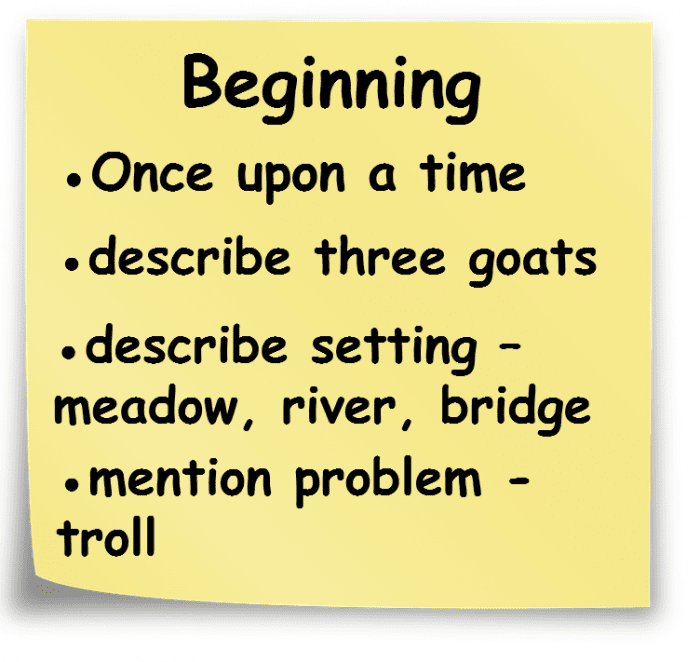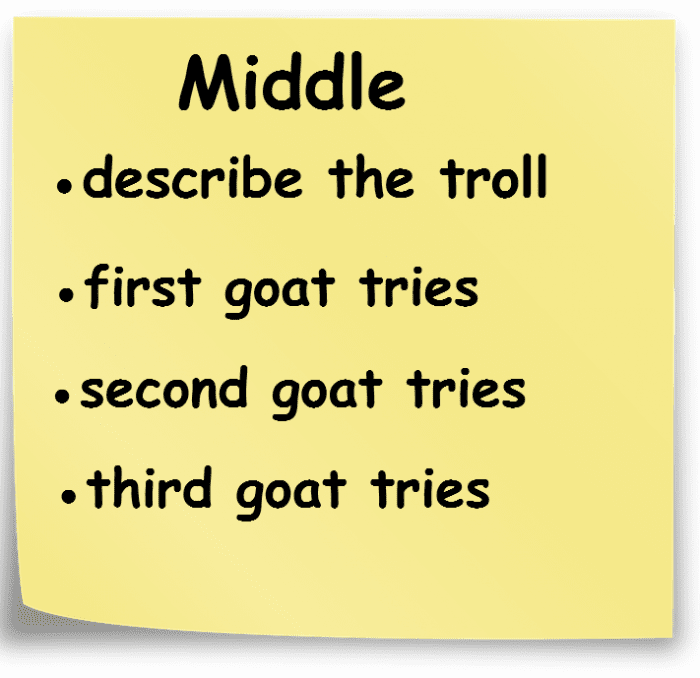- 26th October 2019
- Uncategorised
- MJ's Resources
- 0
Ah planning… this can often be an overly-complicated process that takes forever and may have little value. Pupils can spend ages filling in special planning templates (each one different depending on the text type and maybe even the teacher), which they then ignore when story writing. Even worse, some children just end up copying verbatim what they wrote in their plan as the actual story!
 |
At my school, I recently introduced our Year 3 pupils to post-it note planning. This super simple and ridiculously easy planning method has revolutionised the way pupils plan and write stories.
In this example, pupils were writing their own version of the Billy Goats Gruff. This planning lesson came after pupils had drawn a story map and also drawn and labelled their troll and goat alternatives.
I recapped how stories need a beginning, middle and end. Then, I showed this image of what I was going to include in the beginning of my story.
I used the analogy of a shopping list, whereby writers tick off the items on their list as they include them in their story (they might also add in extra stuff or decide to skip an item on the list – just as a shopper would).
I made clear that the beginning of a story should hook the reader. This is why the last bullet point says ‘mention the troll’. I explained that this could be done directly or even better, indirectly. For example, ‘Whilst the meadow and surrounding forests were picturesque and pretty, not everything was as perfect as it seemed…’
I asked pupils how they were going to hook their reader at the beginning of their stories. Could they explain this now to their partners?
 |
Next, I modeled writing the middle of the story, where the goats try to get across the bridge.
Because I’m using the generic Billy Goats Gruff version as my example, I made sure pupils weren’t just copying this (as you know some will do!) by checking they were using their own ideas.
Although space is limited (intentionally so) on a post-it note, there is still room for pupils to include key adjectives, e.g. about the troll character which will remind them what needs to go into their story.
 |
Finally, we have the end post-it note. In the original story, the big goat ‘butts’ the troll. I asked pupils to think carefully about what verb their character does (e.g. kick, whack with tail, gobble up).
Also, what happens to the baddy? Does it run away? Or suffer some other imaginative fate? This could be an opportunity for some partner talk so children really understand their own plan and story structure.
The third bullet point is very important, even for younger children. This is because it refers to how, in good stories, the main character (or characters) undergoes some kind of change as a result of the plot.
In this simple fairy-tale, my goats learned to stand up to bullies. However, it could also have been the troll who learned not to be mean. I asked pupils ‘What lesson does your character learn?’ Discuss with your partner.’
Children now had a story plan! The next day, I showed them how to use these notes to write a full story.
Post-it note planning is quick, easy and less daunting than traditional planning techniques, such as story mountains and planning templates. As we embed it across the school, by the time pupils reach Years 5 and 6, they should be adept at quickly and efficiently planning the main points of their story as you or I would jot down our shopping list.
Check out my YouTube channel HERE for more teaching ideas and let me know what you think in the comments section below!
Good luck! Stephen 🙂

